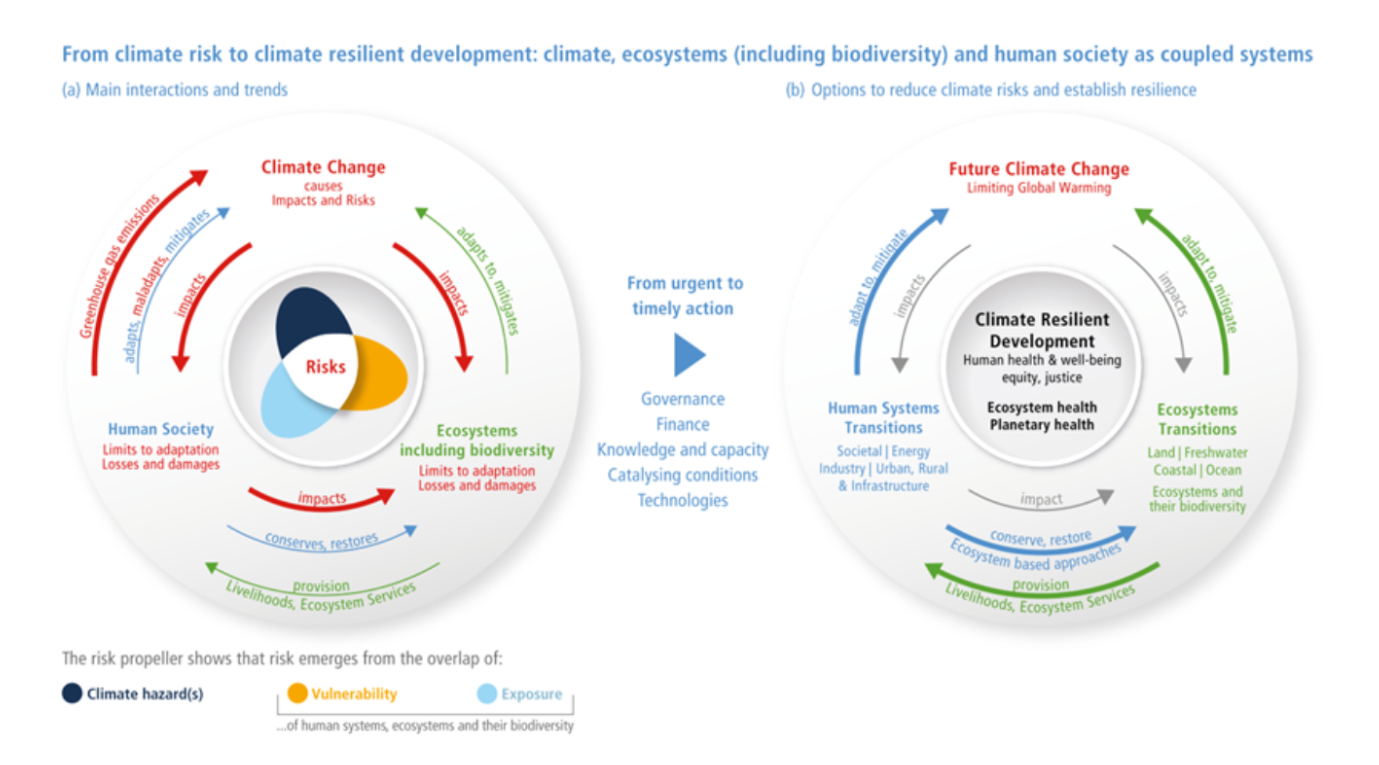Climate Resilient Development: Essence and Relevance for Ukraine?
Climate change is becoming increasingly discussed globally. This was facilitated by the hot summer of last year, when more than a thousand pilgrims died on the streets of Mecca, and the recent catastrophic rainstorms and floods in central Europe. In early October, it came as a surprise to Ukraine that President Biden postponed his trip to Angola and Germany (where a meeting of crucial importance for Ukraine in the Ramstein format was to take place) because of Hurricane Milton, which took a rapid turn for the worse and was due to reach the Florida coast less than two weeks after another devastating hurricane, Helene, which claimed more than 250 lives and left about a hundred missing, with damages estimated at nearly $40 billion. Thus, the intensification of extreme weather events as one of a myriad of manifestations of climate change eventually influenced political processes around the world and in Ukraine in particular.
The most well-known and authoritative organization that analyzes scientific achievements in the field of climate change is the Intergovernmental Panel on Climate Change (IPCC), which was founded in 1988 by two UN institutions: the World Meteorological Organization (WMO) and the United Nations Environment Programme (UNEP) at the request of governments which sought to know what to be prepared for and how to prevent a significant impact on the climate system. The latest, already the sixth IPCC synthesis report on climate change assessment, released in 2023, clearly states: “There is a rapidly narrowing window of opportunity to enable climate resilient development ” (see Figure 1).
What is climate resilient development?
According to the IPCC glossary, resilience is “the capacity of social, economic, and environmental systems to cope with a hazardous event or trend or disturbance, responding or reorganizing in ways that maintain their essential function, identity, and structure, while also maintaining the capacity for adaptation, learning, and transformation.” In general, Ukrainians have demonstrated to the world what resilience means by resisting Russian aggression and showing the ability to develop even in times of war.
What is the definition of “resilience” in the climate-related sense? Obviously, this is a more focused concept. More specifically, according to the same glossary, it is “a process of implementing greenhouse gas mitigation and adaptation options to support sustainable development for all.” In this context, it is worth mentioning the 17 Sustainable Development Goals (SDGs) adopted at the UN summit as a roadmap for 2016 to 2030. Goal 13 is called “Climate Action,” in a more extended version — “Take urgent action to combat climate change and its impacts”, i.e. the urgency of such actions is emphasized in the same way as in the IPCC report (as in Figure 1, “the window is closing rapidly”). Unfortunately, the achievement of the SDGs after more than half of the time allotted for this purpose is in jeopardy, as it was during this period that humanity faced global challenges that the most forward-thinking individuals may have expected, but for which countries and their leadership were not prepared. We are talking about the Covid-19 pandemic, and later, a daunting challenge to global security due to armed conflicts and the inability of existing institutions to prevent or resolve them.
These challenges certainly have nothing but diverted — and continue to divert — resources from addressing and achieving the SDGs. Coming back to Figure 1, such events are marked with lightning bolts and are called “development-disrupting shocks,” and the greater the disruption is, the further away we are from the climate-resilient path, i.e., from green to red lines. Shock events can be of different types and can be either natural (hurricane, earthquake, volcanic eruption, tsunami, etc.) or man-made (war, accident such as the Chornobyl disaster, pandemic, etc.). At the same time, certain natural shock events are also intensified by human impact (see Figure 2 TS.2 on risks).
In particular, in the context of climate change, these are extreme weather events (rain floods, heat waves, large hailstorms, tropical and extratropical cyclones, etc.) or climate impacts that develop slowly, such as rising sea levels, melting glaciers in the Antarctic and high mountains, and sea ice in the polar regions.
Do people in Ukraine notice climate change?
Recent sociological surveys of Ukrainian residents conducted in the spring of 2024 found that climate change is perceived as a serious and very serious challenge to humanity by almost 90% of respondents, with only 7% not considering it a problem. This is in contrast to the results of a similar survey in Ukraine just seven years ago, when at the first parliamentary hearings in 2018, then MP Oleksii Riabchyn announced the results of a sociological survey: in a year, the number of those who considered climate change a problem in Ukraine doubled and stood at 15%. That is, in 2017 there were half as many of them. This is tremendous progress for a country that has been at war for more than 10 years.
Despite these results, Ukrainians, unfortunately, do not always understand the cause of rapid climate change. One can still hear skepticism about the involvement and priority of human economic activity in the climate system, even in environments where there are definitely people with higher education and in leadership positions. The explanation for this should be probably sought in some psychological peculiarities of how shock events are perceived. The first reaction is indeed shock and denial (it can't be, it's not me). Then there is anger and rage (mostly at scientists or politicians: “Why didn't you warn us?”, ‘You don't know anything’), bargaining (searching for “alternative theories” or explanations and magic bullets). After that, depression may even set in (everything is useless, we have already passed the point of no return). And only then does the realization come: if humanity is the cause, then it is still possible to use leverage to solve the problem. In general, one of the conclusions of the latest IPCC report is that one of the main reasons for the slow response to the problem is the reluctance of humanity to change its lifestyle. Education, awareness and targeted communication can also significantly accelerate awareness and later stimulate resources for both climate change adaptation and greenhouse gas emission reduction, in particular through a “green” transformation in the energy sector or nature-based approaches in agriculture, etc.
“Green recovery of Ukraine”
Talks about the “green recovery of Ukraine” began literally from the first months of Russia’s full-scale invasion. At the same time, words matter because it is obvious to everyone that it is necessary to restore the country, that is, to build it in a new and better way instead of “rebuilding it as it was.” On the one hand, the bombed-out thermal generation infrastructure creates a problem with the supply of heat and electricity, especially in winter. On the other hand, Ukraine's thermal power plants were outdated, most of them fueled by coal, which affected greenhouse gas emissions, reduced air quality and exacerbated climate change; moreover, it put us on a par with countries like Russia, which is not at all in line with the EU's goals of achieving climate neutrality by 2050 and, accordingly, the desire of Ukrainian citizens to join the EU.
The New York Times publication analyzed nearly 111,000 satellite images of hundreds of settlements across Ukraine before and after Russia's full-scale invasion and found more than 210,000 destroyed buildings by December 2023. Unfortunately, we know that even more were destroyed in 2024. It is painful to look at the bombed houses and cities that have been reduced to dust. Most of them are still in the active combat zone, where reconstruction is out of the question until our victory and the end of the war.
But Ukraine is moving on and needs new housing and, possibly, new settlements for internally displaced persons, among others. Therefore, Ukraine has a chance to become a leading platform for the whole world to test new technologies and innovations in the construction and other related fields, including distributed generation, accumulation of electricity and, ultimately, circular economy.
This requires appropriate education of engineers, architects and builders, who must understand that these new homes must be designed and built immediately in compliance with climate neutrality. And not only buildings, but the entire space around them should reduce the impact on the climate system by reducing or absorbing emissions, whilst also reducing the risks of extreme weather events. Certain standards have already been developed for this purpose: for example, residents should have access to green spaces in the form of parks or at least squares no more than a five-minute walk away; in addition, “blue infrastructure” should be developed, namely rivers, streams, canals and lakes. At the very least, green spaces should be watered and water should be sprayed around on hot days.
The All-Ukrainian sociological survey “Ukraine of the Future: EU, Post-War Reconstruction, Environmental Issues and Energy Independence in the Eyes of an Average Ukrainian” also confirms that Ukrainians see the importance of convenience in meeting the daily needs of their residents in their vision of the future of cities, i.e., comfort (72.4%), as green cities as possible (60.5%) with clean local water bodies (59.1%), with punctual public electric transport and well-designed routes (57.4%), with emission-free industry and minimal waste (56.8%).
All these demands of society are in line with climate resilient development and the transition from reactive to proactive response to climate risks, as shown in Figure 2, where the key to such a transformation is governance, finance, knowledge and capacity, technology and the conditions under which transformation processes will accelerate.
Unfortunately, the catalyst for green transformation in Ukraine is the war. But we must not lose the chance to rebuild the country better than it used to be.
Please select it with the mouse and press Ctrl+Enter or Submit a bug














 Login with Google
Login with Google